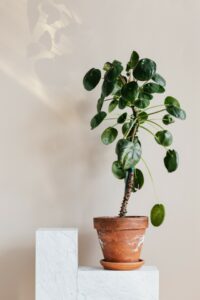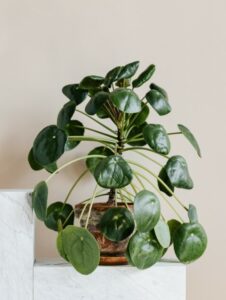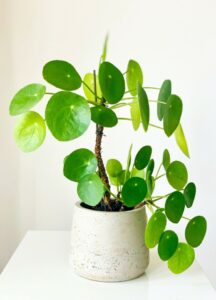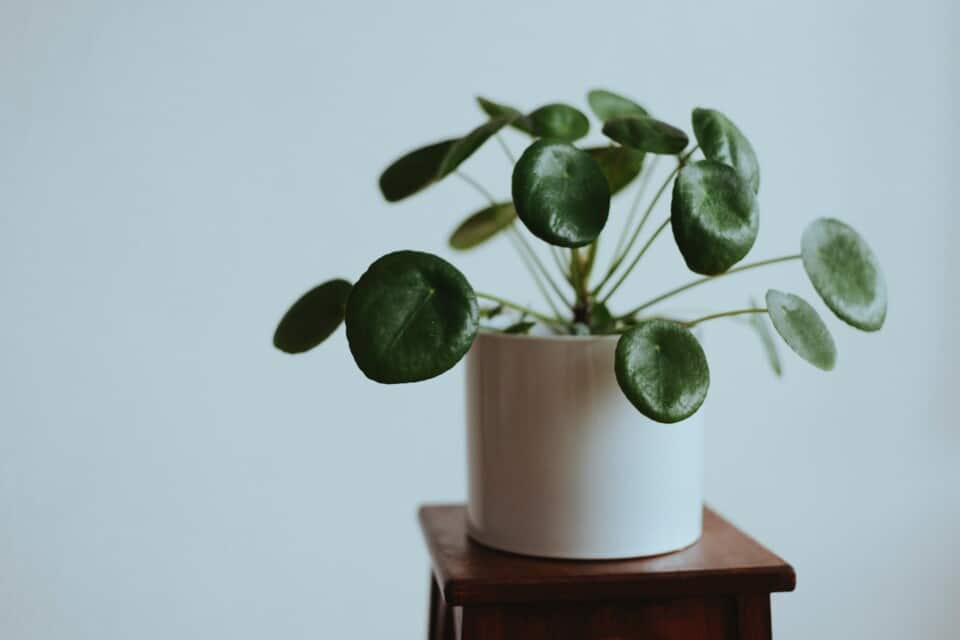Some links in the post are affiliate links and I get a commission from purchases made through some links found in the post.
Anytime I get a new plant, I am always keen on understanding its common problems. And while some people may consider this as inviting bad luck, I view it as a precaution.
When you know what could go wrong, you are better poised to keep it from happening. And with the Pilea, the list is quite extensive
The common problems with a pilea are the leaves curling, pest infestations, the plant drooping, white spots on the leaves, brown spots on the leaves, leaves curling, root rot and the leaves drooping.
So, you need to know what causes such problems and how you can deal with them.
Worry not! This guide takes you through each possible problem and how you can emerge victorious in each challenge.
Let’s get to it:
What Are the Common Problems with A Pilea?
Pilea plants at their best are unique indoor plants that grow up to 12 inches, boasting ornamental benefits that spruce up any space.
In most cases, they are easy to maintain and do not need you to jump through hoops to keep them happy.
But even the easiest of plants have their bad days. And with the Pilea, you should keep an eye out for the following issues:
1) Leaves Curling
The large round leaves of the Pilea are a showstopper and a good motivation behind the popularity of this plant. So, to see them curling can leave you wondering why this is the case. Leaves can curl for different reasons, including:
1) Exposure to Heat
 While the Pilea does well in warm regions, it does not enjoy direct exposure to heat.
While the Pilea does well in warm regions, it does not enjoy direct exposure to heat.
As a result, when it’s left exposed to heaters, hot air, direct sun, or any other heat sources, its upper leaves curl. The good news is that dealing with such curling is an easy task.
All you need is to move the plant to a spot where it is no longer exposed to the heat. For example, if the plant is near a heater, you can move it away from the heater, and that should do the trick
2) Overwatering
Did you know that giving too much water can result in leaf curling on the lower side of the plant? That’s right! The Pilea prefers moderate watering.
As a rule, you should only water the plant when the top two inches of the soil feel dry. Else, the water remains in the soil, creating the perfect conditions for root rot.
And curling is but one of the signs that your plant’s roots are under attack. If left undealt with, root rot can kill the Pilea.
3) Pest Infestation
As pests feed on the plant’s leaves and suck on its juices, they leave the leaves curled. If you notice such curling on the leaves on the lower region of the plant, assess the plant for any signs of infestation.
2) Pest Infestations
The thought of waking up to a pest-infested plant can feel disheartening. After all, many plant pests are hardly noticeable until they wreak havoc on your plant. What pests attack Pilea plants?
- Spider mites: These form webs on the undersides of the leaves.
- Fungus gnats: These fly around the plant and are highly similar to fruit flies. However, these hang around the plant rather than the kitchen or dustbin.
- Mealybugs: These pests exhibit as small dots on the bases and nooks of the leaves.
Of course, there are more culprits to blame for pest infestations. But for now, we will focus on the main ones and how you can deal with them.
Like any problem, the best way to deal with pests is to prevent them from attacking your plant in the first place.
And the best way to do this is by providing your plant with what it needs – adequate light, moderate watering, regular feeding, etc.
Moreover, you should also inspect the plant regularly for any signs of infestation – the sooner you catch a pest, the easier it is to eliminate it.
What happens when a pest infestation has already spread? In this case, your best bet lies in controlling the infestation to prevent it from spreading to other plant parts.
You can remove them by hand or clean the plant with water and organic soaps.
Depending on how severe the attack is, you may need to rely on homemade solutions or invest in insecticidal sprays and soaps to prevent pests from spreading.
3) Plant Drooping
Pilea plants look their best when they are firm. However, drooping can also occur when the plant faces the issues below:
1) Irregular Feeding
While the Pilea is not an avid feeder, it still needs a boost in nourishment when growing indoors because potting mixes rarely have enough to support plant growth.
Luckily, the plant needs feeding only twice each year – once in the summer and the spring. When feeding the plant, use a liquid houseplant fertilizer diluted to half its strength. You don’t need to feed the plant in the winter.
2) Underwatering
If your plant is well fed and still shows signs of drooping, the plant may not be getting enough water to support its cellular activities.
Firmness in the plant comes down to efficient diffusion, which owes to water uptake from the roots.
But when the soil is dry, the roots cannot absorb much, which hurts diffusion processes, resulting in drooping plant parts.
Solving this issue is easy. You should check if the top two inches of soil are dry. If they are, you should water the plant, ensuring you soak the soil thoroughly until the excess water drains from the pot.
Keep up with this regular watering schedule, and your plant should perk up soon.
4) White Spots on the Leaves
What can cause white spots on your Pilea? There are two main causes:
1) Mineral Deposits on the pores of the leaves
 Depending on where you live, the water in your home could contain heavy metals. Over time, these accumulate and get lodged in the leaf pores.
Depending on where you live, the water in your home could contain heavy metals. Over time, these accumulate and get lodged in the leaf pores.
Unfortunately, these deposits can bar photosynthesis from taking place, ultimately leading to more problems.
To deal with this issue, you must change the water used to water the plant. If you can get mineral or filtered water, that would be great. But if you can collect rainwater, that would be the best solution.
2) Pest infestation
Some pests exhibit as white spots on the leaves. You should use a magnifying glass to inspect the leaf surface and check if the white spots move.
If your plant has a pest infestation, you must act fast to control the situation before it worsens.
5) Brown Spots on the Leaves
We all know that a healthy Pilea should have green leaves. So, what can cause browning? There are a few possible reasons:
1) You use too much fertilizer
When the Pilea grows outdoors, you do not need to use fertilizer as the soil contains the essential nutrients to promote plant growth.
But when growing the Pilea indoors, you may need to supplement the soil with regular feeding. It’s advisable to use a liquid houseplant fertilizer diluted to half its strength.
Apply this once in the summer and again in the spring. What happens when you go beyond this limit? Fertilizers can burn the leaves.
And this is what you will see as brown spots on the leaves. Unfortunately, you cannot undo the effects of excess fertilizer.
All you can do is prevent similar occurrences by abiding by the recommendations. It’s better to use less fertilizer than to go overboard.
2) You give the plant too much water
I mentioned that overwatering could cause leaf curling. But that’s not the only problem that results from overwatering.
Like most succulents, the Pilea does not appreciate being in waterlogged soil. And once root rot starts spreading, the plant leaves turn brown.
If you can rule out the other possible causes of browning, you will need to assess your watering schedule. Only water the plant when the top inches of the soil are completely dry.
Then wait for the soil to dry out again before watering it. When in doubt, it’s best not to water the plant. While underwatering is also an issue, it does not have devastating effects like overwatering.
3) The plant has direct exposure to the sun
Pilea is a genus that comprises hundreds of species that grow in tropical regions. Most of these species do well in bright and indirect light.
As such, if you leave your plant directly exposed to the sun, the rays burn the leaves, resulting in browning. How can you prevent this?
You cannot change the effects of the sun’s rays. Thus, any browned leaves will need to be cut off or ignored as this will not change.
However, you can protect the plant from further damage by situating it next to a window where it does not get any direct sun exposure.
The best light for this plant is a partial shade or partial sunlight. Every two weeks, you should rotate the plant to prevent one side from leaning towards the sun.
To learn more about what light your pilea needs, we have a full article on the light requirements for a pilea.
4) Your plant has a pest infestation
It’s clear that Pilea plants do not like pests. Crawling pests enjoy sucking on the plant juices, thus damaging the plant tissues and leaving the foliage brown.
The only way to deal with this is to eliminate the pests. Keep in mind that your plant will be more prone to pest attacks if it does not get the care it needs.
Thus, you should start by providing it with adequate water and lighting to boost its immunity.
If you would like some more information, we have an article on why are my pilea leaves turning brown.
6) Leaves Dropping
Imagine waking up one day to find that your precious Pilea leaves are falling out one after the other. What could be the problem?
Leaf drop does not result from one but rather from a myriad of factors. And when it ensues, you must question the care you give to your plant. These include:
1) Light
Does your Pilea have access to bright and indirect light? Direct sun exposure burns the leaves and causes browning and yellowing, hurting the plant’s ability to make food.
Low light is also not good for the plant as it causes the plant to exhibit leggy growth and makes the foliage turn dark green. If you cannot find a spot with bright and indirect light in the house, consider using grow lights.
To fix leggy growth we have created an article to help stop your pilea from becoming leggy.
2) Soil
Is your potting mix well-draining? Using a potting mix with compacted soil deters water from leaving the pot, and this causes waterlogging, leading to root rot.
And root rot can kill the plant. To fix this, use a peat-based potting mix for your plant.
3) Pot
Does the pot have adequate drainage holes? Root rot is the most common cause of leaf drop. As such, you must always ensure the drainage holes are not blocked. Only then can they freely allow excess water to drain out of the pot.
4) Roots
Is the plant rootbound? You can tell by wiggling the plant out of the pot and checking if its roots are compacted. Ideally, you should repot the Pilea once every 1 to 1.5 years.
5) Watering Schedule
Does your plant get adequate water? You should only water it when the top two inches of the soil are dry. Any more than this can cause waterlogging which paves the way for root rot.
Underwatering is also an issue with Pilea. If you have trouble gauging when to water the plant, please invest in a moisture gauge as it can help you know when the soil is dry and when it does not need more moisture.
6) Temperature
You should not leave the plant in temperatures below 50 degrees Fahrenheit as these can be deadly.
Instead, aim to have the plant in a room where the temperatures are between 60- and 95-degrees Fahrenheit, away from cold and hot drafts. The plant is not specific about humidity and will do well in moderate to high humidity levels.
To get the right humidity for your pilea, check out our article on what is the ideal humidity for a pilea.
7) Feeding
 Your Pilea only needs fertilizer twice a year in spring and summer. And in both cases, you should use a liquid houseplant fertilizer diluted to half its strength.
Your Pilea only needs fertilizer twice a year in spring and summer. And in both cases, you should use a liquid houseplant fertilizer diluted to half its strength.
Consider the care requirements above whenever you face any issues with your plant. Are you meeting them? If not, make the necessary adjustments, and your plant will do much better.
For more information on leaves drooping, we have an article on how to stop your pilea leaves from drooping.
Final Thoughts
The Pilea is generally easy to care for, making it an excellent starter plant. No matter your level of gardening expertise, this plant should thrive under your care. Happy Gardening!
If you enjoyed this article, check out our article on how big can a pilea get.

